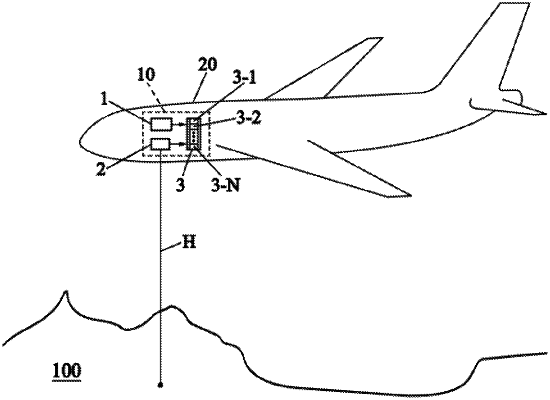| CPC G06N 7/01 (2023.01) [G01C 21/165 (2013.01); G01C 21/188 (2020.08); G07C 5/0808 (2013.01)] | 20 Claims |

|
1. A method of box regularized particle filtering, for predicting a state of a system, comprising at least one execution of a sequence which includes the following steps:
/1/ a prediction step, comprising a predicting of subsequent state intervals, each subsequent state interval being obtained by applying at least one propagation rule to one among a plurality of previous state intervals;
/2/ a step of measuring a actual state of the system;
/3/ a step of contracting at least one of the subsequent state intervals, as a function of at least one measurement result of the actual state that was obtained in step /2/;
/4/ a weight update step, comprising an assigning of a weight to each subsequent state interval as a function of a size of said subsequent state interval as resulting from step /3/, of a size of said subsequent state interval as resulting from step /1/ before step /3/, and of a weight of the previous state interval from which said subsequent state interval resulted during step /1/; and
/5/ a step of redistributing the subsequent state intervals, comprising a replacing of at least one of the subsequent state intervals i by ni sub-intervals obtained from a division of subsequent state interval i, i being an integer index numbering the subsequent state intervals and ni being a number of the sub-intervals which replace said subsequent state interval i, each sub-interval being intended to constitute a previous state interval for a subsequent iteration of the sequence of steps /1/ to /5/,
wherein step /5/ comprises an initializing of the number of sub-intervals ni, and comprises the sequence of following sub-steps /5-1/ to /5-4/ which is performed for each of the subsequent state intervals alternatively used as a reference interval:
/5-1/ initially adopting the reference interval as retained state interval;
/5-2/ obtaining a number which is between 0 and 1, called random factor, by a drawing method considered to be random, and selecting one of the subsequent state intervals, different or not different from the reference interval, as a comparison interval, by a selection method considered to be random;
/5-3/ if a result of multiplying the random factor by the weight of the reference interval, as updated in step /4/, is less than the weight of the comparison interval, also as updated in step /4/, then replacing the previously retained state interval by the comparison interval;
sub-steps /5-2/ and /5-3/ being repeated several times for each subsequent state interval used as a reference interval, then
/5-4/ incrementing by one the number of sub-intervals intended to replace the state interval that is retained at the end of the repetition of sub-steps /5-2/ and /5-3/; and
each subsequent state interval then being replaced in a sub-step /5-5/ by sub-intervals obtained from a division of said subsequent state interval, in accordance with the number of sub-intervals which results for said subsequent state interval from all executions of sub-step /5-4/.
|